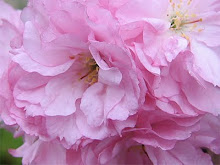After
I cut some of the lemon balm and set it to drying in the attic, I
started compiling a list of common names that lemon balm is also
known by. Now that we have the Internet, it'll be interesting to look
them up and see how people are using lemon balm. For example, I see that
there is a company named after "Blue Balm" that makes handmade soap.
The scientific name for lemon balm is "melissa officinalis" and it belongs to the Lamiaceae or Labiatae
mint family of flowering plants. Other common names include sweet balm,
melissa, Zitronenmelisse (German), citronelle (French), and melissa
(Italian). (no. 91, Simon and Schuster's Guide to Herbs and Spices)
The Herb Book, by John Lust, has a longer list of common names, including:
• balm mint
• bee balm
• blue balm
• cure-all
• dropsy plant
• garden balm
• lemon balm
• melissa
• sweet balm
(See page 105, "028 Balm.")
I
can understand why it's called a "dropsy plant"! We have it growing on
either side of a walkway and after it grows to three feet tall, it
starts drooping over, making it harder to walk there. (I learned from the Internet that the word "dropsy"
means to fill up with fluid.)
However, according to Wikipedia, lemon balm is not to be confused with bee balm, which is a different genus. Also, there is a balm mint plant that is a native Australian hardwood shrub that can grow up to two meters tall.
Other common names (listed on various websites) include:
• sweet mary
• honey plant
and just plain
• balm
What Others Have To Say About Lemon Balm
Here are some of the properties and uses for lemon balm that are mentioned in my books on herbs:
According to Simon and Schuster's Guide to Herbs and Spices, edited by Stanley Schuler:
• "Lemon balm has antipyretic, refreshing, cholagogic, and stimulant properties; and melissa water is a well known calmative." (See number 91.)
Leslie Bremness in the Eyewitness Handbook, Herbs: A Visual Guide to More Than 700 Herb Species from Around the World, says
Fresh lemon balm leaves:
• Add a delicate flavor to food dishes, oils, vinegars, and liqueurs
• Provide a relaxing bath
• Soothe insect bites
• Make a sedative and tonic tea
(Evidently, lemon balm tea has a reputation for giving longevity and for soothing headaches, indigestion, and nausea.)
• Extracts made from lemon balm are antiviral and used to clean and heal wounds by starving bacteria of oxygen.
• The lemon balm essential oil is refreshing, an antidepressant, and helps some eczema and allergy sufferers.
•
And finally, an interesting note is this book says that lemon balm
"attracts bees, and if rubbed on empty hives will encourage new
tenants."
One of the featured articles this month at the Virginia Gardener Magazine web site is a great one about "Lemon Balm—the Scent of Sweet Dreams and Calm Nerves" by Anna Holton.
Fresh Lemon Balm Tea
And while I was waiting for the herb to finish drying up in the attic, I decided to try a cup of hot tea made from a bunch of fresh
lemon balm leaves. I picked about a dozen large leaves, washed them, and
stacked them on top of each other. Then I cut the stack into tiny
pieces and placed them in a glass mug. I poured boiling water over the
herbs, covered it with an upside-down plate, and let it steep for about
15 minutes. I liked it!—It was surprisingly refreshing, with light and
delicate flavors of lemon and mint.
Related blog articles:
skip to main |
skip to sidebar





Fall Lake 01

Blossoms #09

Cookoff #74

Anthony's #01

Anthony's #054

Rodeo #011

Fall Colors 01

Yosemite Rocks 02

Old Truck 02

Sweet Cherries 03

Harvest 09

Church Flowers 09

Tree Ornaments #11

Golden Gate Bridge #2

Fall Leaf 01

Sunrise in Alabama Hills #11

Yosemite Valley 01

Sunset Colors #6

Gladgladiola 03

Redwood Pink #3

Brick Wall 01

Chinatown 05

Cactus 102

Tyrolean #12

Chinatown 01

Cookoff #89

Cacti 06

Cactus #06

Cookoff #61

Saltwater #0003

Cookoff #56

Purple Saffron Flowers

Closeup of a Thistle

Cookware #0001

Cactus #0003

Multi-Tulips #2

Red Apple #02

Coast Tracks #01

Wall #003

River #11

Green Kale #01

Red Yellow Tulips #2

Brussels #09

Butterfly #09

Cactus #9

Thistles #04

Coast Crops #04

Daffodils #3

Drinks #3

Garlic #02

Multi-Flower #02

Park Field #08

Purple Flower #07

Yellow Rose #05

Thistles #005
I'm on the road, in search of food — food for my body, food for my mind, food for my soul. I dedicate this blog to peanut butter, my best friend. Food is what we're all about. Cheers!
About This Blog
I love food. I’m a vegetarian practicing Macrobiotics, married to a “meat-eater,” and friends with “meat-eating” cats (some of these friends really like chopped raw chicken liver, slightly warmed). My husband and I love to travel and we love to explore new foods wherever we go!
What is food? I define it as anything that we eat or drink, regardless of how nutritious it may be for our individual bodies. I also consider the air that we breathe, water we drink, sunshine we absorb, the beauty we see, and music we hear to all be food for our bodies, minds, and souls!
I’m very interested in food as nutrition and I have discovered how the principles of Macrobiotics are the key to balanced health and our happiness. It has been very helpful for managing my weight (which has always been a problem) and for dealing with various ailments and/or life changes.
What is food? I define it as anything that we eat or drink, regardless of how nutritious it may be for our individual bodies. I also consider the air that we breathe, water we drink, sunshine we absorb, the beauty we see, and music we hear to all be food for our bodies, minds, and souls!
I’m very interested in food as nutrition and I have discovered how the principles of Macrobiotics are the key to balanced health and our happiness. It has been very helpful for managing my weight (which has always been a problem) and for dealing with various ailments and/or life changes.
My Favorite Web Sites
Search This Blog
Blog Archive
-
►
2011
(101)
- ► January 2011 (18)
- ► February 2011 (14)
- ► March 2011 (9)
- ► April 2011 (11)
- ► August 2011 (10)
- ► September 2011 (2)
- ► October 2011 (4)
- ► November 2011 (3)
- ► December 2011 (6)
-
▼
2012
(23)
- ► January 2012 (2)
- ► February 2012 (4)
- ► March 2012 (1)
- ► August 2012 (2)
- ► October 2012 (1)
- ► November 2012 (1)
- ► December 2012 (2)
-
►
2013
(20)
- ► January 2013 (7)
- ► February 2013 (11)
- ► April 2013 (1)
- ► November 2013 (1)
-
►
2014
(5)
- ► February 2014 (1)
- ► August 2014 (2)
- ► September 2014 (2)

Fall Lake 01

Blossoms #09

Cookoff #74

Anthony's #01

Anthony's #054

Rodeo #011

Fall Colors 01

Yosemite Rocks 02

Old Truck 02

Sweet Cherries 03

Harvest 09

Church Flowers 09

Tree Ornaments #11

Golden Gate Bridge #2

Fall Leaf 01

Sunrise in Alabama Hills #11

Yosemite Valley 01

Sunset Colors #6

Gladgladiola 03

Redwood Pink #3

Brick Wall 01

Chinatown 05

Cactus 102

Tyrolean #12

Chinatown 01

Cookoff #89

Cacti 06

Cactus #06

Cookoff #61

Saltwater #0003

Cookoff #56

Purple Saffron Flowers

Closeup of a Thistle

Cookware #0001

Cactus #0003

Multi-Tulips #2

Red Apple #02

Coast Tracks #01

Wall #003

River #11

Green Kale #01

Red Yellow Tulips #2

Brussels #09

Butterfly #09

Cactus #9

Thistles #04

Coast Crops #04

Daffodils #3

Drinks #3

Garlic #02

Multi-Flower #02

Park Field #08

Purple Flower #07

Yellow Rose #05

Thistles #005
